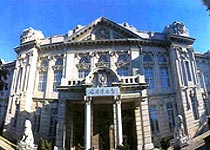 |
The Lvshun Museum, located at Lvshunkou District of Dalian City and founded initially in April 1917, is a historical and art museum of China. After the Japanese occupation of Dalian in 1905, the Japanese Imperialists built the Museum in 1916 on the basis of the officers' club unfinished by the Tsarist Russia. The Museum features its modern European architectural style with oriental artistic decoration. It used to be called the "Exhibition Hall of Manchurian and Mongolian Products ofGuandong(the Northeast) Governor's Residence". Its name was changed successively into the "Museum ofGuandongGovernor's Residence" in November 1918, the "GuandongDepartment Museum" in 1919, the "Lvshun Museum" in 1934, and the "Lvshun Oriental Cultural Museum" in October 1945 after being taken over by the Red Army of the Soviet Union. On February 1, 1951, the Soviet army turned over the building of the Museum together with its collection of 20,637 items of historical and cultural relics and 7,700 volumes of books to the Chinese government. In December 1952, the Museum was renamed "Lvshun Historical and Cultural Museum" and in 1954 the name of the museum was finalized as "Lvshun Museum". Under the jurisdiction of the Museum are two other exhibitions sites, the former site of the Lvshun Japanese and Russian Prison and the Tomb of Unknown Patriots.
The Museum has collected over 30,000 items of relics, of which 45 belong to Class One collection. The rare collections include the copper tripod from the Western Zhou Dynasty (c.1100-771BC) with 44 characters in five lines inscribed inside the bottom of the tripod, the gold bullion in the shape of hoof from the West Han Dynasty (206BC-24AD) andthe Drawing of Bamboo and Rocksdrawn by Liu Bingqian in the Yuan Dynasty (1271-1368). In addition, there are also nine mummies from the Southern and Northern Dynasties (420-550) to the Tang Dynasty (618-907) unearthed in Xinjiang, the relics from the Han Dynasty (206BC-24AD) and Tang Dynasty such as silk fabrics, Chinese classic paintings on silk, pottery figurines, and coins, as well as foreign relics such as the stone carving from India and paintings from Japan.
The basic exhibition of the Museum can be divided into two parts. The first part is the Special Exhibition of Historical Relics, displaying bronze handicrafts, sculptures, lacquerware, enamel, inkslab, ceramics, painting and calligraphy, and Buddhist artworks. The second part is the Exhibition of Local Historical Relics of Dalian, displaying the historical relics of Dalian fromthe Neolithic Age to the Qing Dynasty (1644-1911). Displays on special topics were also held such as the Relics Unearthed from Xinjiang and the Chinese and Foreign Coins, totaling 3,101 items of relics on display. Other exhibitions on specific topics and roadshows were also held such as the Display of Relics Unearthed in Dalian, the History of Development of Weaponry, the Bronze Technology, the Exhibition of International Gifts, the Exhibition of Artworks through the Ages, the Exhibition of Qi Baishi's Paintings, the Exhibition of Xu Beihong's Paintings and the Exhibition of American Imperialism's Aggressive Crimes against China.